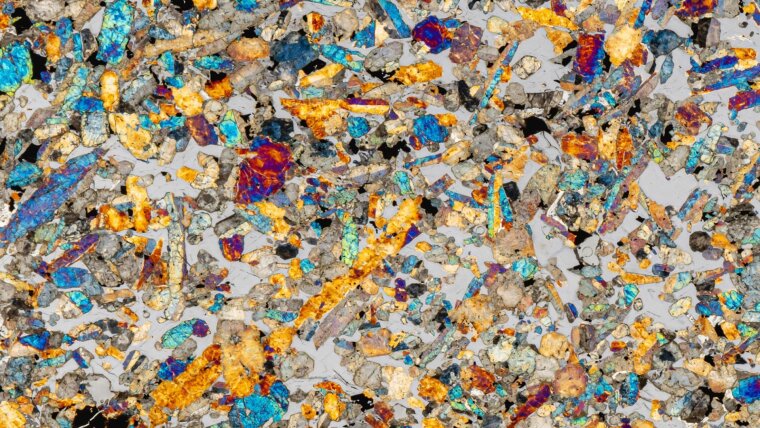
The matter found on Earth also exists in space – after all, that’s where it came from. It is mostly crystalline, but various processes have also produced glass from the same chemical components. Scientists at the University of Jena are analysing this glass from space and simulating its formation. This is opening a window for them to explore distant regions of the universe, back in time to the infancy of our solar system – and sometimes even beyond.
By Sebastian Hollstein
When meteorites land on Earth, space is sending us a postcard from the distant past. Many extra-terrestrial pieces of rock are ancient and originate from celestial bodies like asteroids, which were formed a little more than 4.5 billion years ago and have hardly changed since then. These primitive, unmodified meteorites are also known as »chondrites«. Their name is derived from »chondrules«, tiny silicate globules minerals measuring just a few millimetres in diameter that make up most of the meteoritic material that falls on Earth. These globules often contain glass.
In the solar nebula, the cloud of gas and dust from which our solar system emerged, there were processes early on that led to sudden increases in temperature. We are yet to discover what exactly caused those temperature excursions. In this environment, the siliceous matter formed melt droplets, which then cooled and solidified. »If they cooled down quickly, glass was formed«, explains Prof. Dr Falko Langenhorst. »Today, we can use thermal analysis methods to work out how quickly the heating event took place. These data tell us more about the temperature distribution and fluctuations in the solar nebula, which ceased to exist billions of years ago«.
Even older glass could be found in comets. They contain dust particles, some of which originate from the interstellar medium, the region between a galaxy’s stars. The tiny particles were released into space when ancient stars died, making them older than our solar system. The particles became embedded in planets, asteroids and comets during the emergence of our solar system.
»We’re unable to directly retrieve samples from the distant regions between the stars. But we were able to collect such dust in regions of space that are closer to us, such as from the tails of comets as was done by the Stardust mission, or from celestial bodies such as the Itokawa asteroid from which the Hayabusa space probe brought back soil samples to Earth in 2010«, explains Langenhorst. »If we examine the isotopic composition of the samples, we can then identify particles originating from the interstellar medium«.
Mineralogist Prof. Dr Falko Langenhorst recreates the extreme conditions under which glass is formed in space in laboratory experiments.
Image: Jens Meyer (University of Jena)It is believed that the siliceous stardust in particular was originally amorphous and had the best chances of surviving in such a glassy form in comets, because they have never been heated up since the formation of our solar system.
However, it was very difficult to detect those glasses, because the particles are usually smaller than a millionth of a metre. Some of the samples collected during the Stardust mission also ended up in the hands of Prof. Dr Falko Langenhorst, who worked with his team to successfully locate the glass particles using a transmission electron microscope, an imaging method with almost atomic resolution.
»The glass in stardust is essentially formed by cosmic radiation, a stream of high-energy elementary particles, such as protons, which emanate from stars and convert crystalline matter into glass. Such processes are happening constantly in space and, as the dust mostly consists of silicates, we can assume that there is a lot of glass in the interstellar medium«, says Langenhorst.
The effects of space weather
However, the bombardment with high-energy elementary particles not only changes the matter in the interstellar medium, but also the surfaces of celestial bodies in our solar system that have no atmosphere and are therefore exposed to the barrage of particles without protection.
This is referred to as »space weathering« which, in our solar system, is mainly caused by streams of charged particles from the sun known as »solar wind«. Just as terrestrial rock is eroded by the weather and the associated chemical processes, celestial bodies such as asteroids and the moon are also altered by external influences.
And when high-energy microparticles hit the surface, this often leads to the formation of glass. The particles only penetrate the matter by fractions of a millimetre, giving the surfaces a glassy film.
In order to understand exactly how such weathering processes take place, Langenhorst and his team have simulated high-speed collisions with the help of gas guns and laser bombardment. As a result of their experiments, they have found that the weathering not only alters the surface structure of celestial bodies without an atmosphere, but also causes chemical elements to be redistributed in space.
For example, contact with solar wind transforms sulphides into amorphous structures on Itokawa and the moon, releasing gaseous sulphur into space. »What remains is iron, which is deposited on the surface like needles«, states Langenhorst. »This information is helping us to interpret the remote spectra and to explain, for example, why asteroids have highly variable concentrations of sulphur: They must have been affected by varying degrees of space weathering«.
Under pressure
Extra-terrestrial influences and regions also produce a glass that was formed in a very unusual way. While the raw material of chondrules is melted at high temperatures and then quenched to form a glass, »diaplectic glasses« are formed when a mineral’s original crystalline structure is destroyed under high pressure, which also brings about its key distinguishing feature: a higher density.
»The pressures required for this process are in the range of hundreds of thousands of bars and occur on Earth primarily when an asteroid or comet hits the planet«, explains the expert from the University of Jena. »It is often difficult to find evidence of such impact events on Earth because plate tectonics, erosion and weathering have eliminated the morphological traces of the craters. However, one clear indication is the presence of this glass in the materials ejected from impact craters, some of which are distributed throughout the planet«.
For example, diaplectic glass can be found in the ejecta from the meteorite impact that caused the depression in the Nördlinger Ries, a region located to the east of Stuttgart that was hit by an asteroid measuring one kilometre in diameter around 14.6 million years ago.
Falko Langenhorst and his colleagues at the German Electron Synchrotron (DESY) in Hamburg are researching exactly how such glass is formed under pressure by subjecting samples to high pressure in a diamond anvil cell and observing when the sample vitrifies in the course of the experiment. »We’ve found out that vitrification doesn’t happen straight away – the material goes through a metastable intermediate stage first«, explains the mineralogist from the University of Jena.
»The glass isn’t formed randomly in the volume of the crystal, but in the form of thin strips. The initial crystal is streaked with amorphous layers, which then widen under increased pressure until the entire crystal has been converted into a glass«. Their research results lay the foundation for diaplectic glasses to be used for specific applications in the future.
